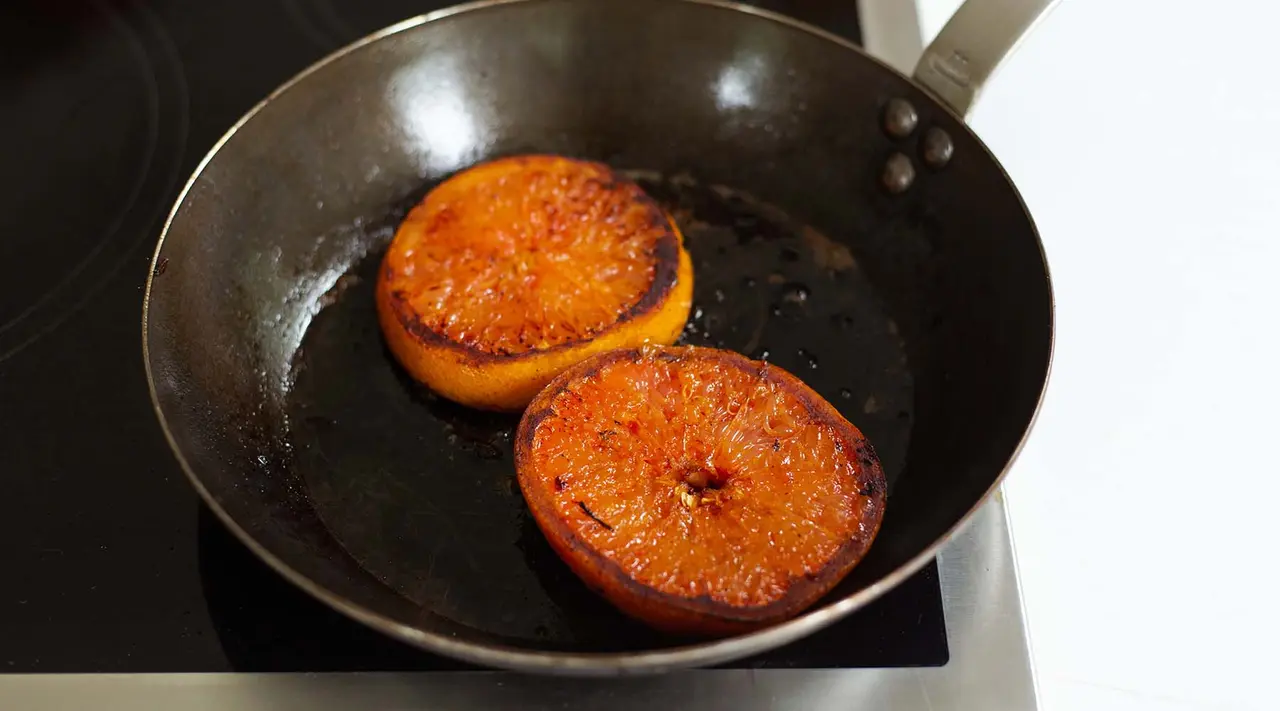Of all the major food groups, none is quite so pigeonholed as fruit. Grains, meats, veggies and legumes serve so many different functions in the kitchen. But produce tends to take a back seat, playing a passive role to more versatile, dynamic ingredients.
Sure, grabbing an apple for breakfast or a handful of blueberries at lunch is super satisfying. But why can’t fruit be the star of the show? Can’t a sweet, ripe, juicy piece of produce be the ‘main’ ingredient that steals the spotlight from its culinary castmates? Here at Made In, we say yes—it can!
Whether we’re talking grapefruits, strawberries, cherries, bananas, peaches, oranges, tomatoes (don’t fight us on this one) or grapes, our favorite fruits are all capable of new, exciting preparations. In particular, one method takes fruit beyond the raw movement in a way most people would never guess.
Are you sear-ious?
Through the searing and caramelizing process, it’s possible to transform a fruit’s taste, texture and consistency while still retaining the wonderful properties that make up its essence. And yes, we realize that there’s something sorta scary about ‘heating up’ fruit. It’s a food we’re so used to enjoying crisp and cold, but don’t worry—it’ll all be worth it.
Today, we’re taking a look at 5 different produce types that are perfect for this preparation method. Ready for a taste of the tropics on your stovetop? Not so fast. We have a few things to consider.
First, to tackle these simple recipes, you’ll need a high-quality stainless steel or carbon steel frying pan to sear these little suckers into oblivion (is that too aggressive?). The Made In cookware shop has a ton of excellent choices to choose from, all of which are perfect for searing practically ANY ingredient—including fruit.
Next, let’s talk about technique.
Tips for Searing Fruit in a Frying Pan
The process of ‘caramelizing’ fruit is essentially breaking down its starchy parts into delicious, irresistible sugar. Now, since fruit already has plenty of natural sugar, introducing high heat can help enhance its flavor and draw out even more sweetness. This is perfect for when you’re making dessert dishes like pies, tarts and other pastries.
Also, caramelizing fruit tends to soften its flesh and slightly darken its coloring. Once the flesh is tender, it soaks up any surrounding liquids, infusing even more flavor into the dish. If you think you can handle this deliciousness, get the following strategy down:
- Preheat your frying pan on the stovetop using medium to high heat
- Add some sort of caramelizing agent such as oil, butter, or an already cooked combination of sugar and salt (which eventually melts into a brown liquid)
- Position sliced fruit in the pan, making sure to distribute evenly so that every piece has contact
- Let cook and stir throughout the process until fruit softens and darkens
- Allow your sweet, fruity creation to slightly cool before serving
- Refrigerate and allow to fully cool for future enjoyment
Now that you know the basics, let’s get this produce party poppin’!
5 Fruits You Should Definitely Sear
Grapes
We have no problem stomping on grapes for wine. So where’s the love in the heart of the home? By sautéing these plump little guys with a bit of honey in the bottom of a pan, they start to blister and take on an amazingly sweet, caramelized flavor.
Chefs recommend using red grapes, as they’re typically the sweeter variety (compared to the more sour green ones). Take the fruit off the heat after a few minutes of stirring, and it retains its general shape. The difference is in the richer, sweeter flavor and darker, more shriveled appearance.
Recommended recipe: Caramelized Grape Brie and Walnut Bites from Kitchen Confidante
Grapefruit
Did you know that searing a grapefruit creates an unexpectedly sweet treat? There’s nothing lovelier than a fresh grapefruit halved, sprinkled with sugar and topped with a cherry. But when you slice it into thick rounds and plop its flesh down on a hot frying pan, the results are even sweeter!
Put a generous pat of butter in the bottom of the pan, heat until melted, and then sear each slice of grapefruit for about 20 seconds on each side. Enjoy solo while the exterior is warm (and the inside is still cold and juicy). You can even garnish with various extras, as in our spotlight recipe below.
Recommended recipe: Seared Grapefruit with Ginger Maple Syrup from NY Times Cooking
Tomatoes
They’re the cornerstone of countless dishes, sauces, condiments and sides. But it’s rare that we get to enjoy tomatoes somewhere in between—not quite raw, not quite cooked. That’s where today’s sensational searing technique comes in.
The next time you’re cooking morning breakfast, use leftover grease in the pan—from bacon, or butter from your eggs—to lightly sear some small-to-medium sized tomatoes on the vine. By browning them on each side (roughly 2-3 minutes total), the fruit begins to break down, rendering the taste sweeter. The texture will also be softer thanks to the pan’s yummy blistering action.
Recommended recipe: Steak, Eggs & Seared Tomatoes from Real Simple
Peaches
This one’s a given! Of all the fruits in the basket, peaches have long been ‘cooked’ for use as pie filling and with other pastries. Still, there’s no reason why these caramelized treasures can’t be the main star of the dish!
Start by tossing some ripe slices of peach with lemon juice and a sprinkle of salt and cinnamon. Add butter to your pan, let melt, then introduce the peach mixture, caramelizing for about 5 minutes until it transforms to a golden brown. The result? Sweet, melt-in-your-mouth manna from heaven. In Martha Stewart’s version below, you can even add bourbon or rum during the cooking process for another level of rich flavor.
Recommended recipe: Caramelized Skillet Peaches from Martha Stewart
Bananas
Been to a wedding lately? Then you’ve likely tasted the sweet, buttery, cinnamon goodness of banana’s foster. But let’s face it—ain’t nobody got time for that. Flambe, no way. If you’re looking to spice up your bananas at home, there’s a 10-minute trick that is just as tantalizingly delicious. Consider this a lesser-known version of the catering hall favorite.
Seared bananas (unlike the fully caramelized kind) offer a crispy, golden-brown bite on the outside, but the sweet, fleshy texture of a typical banana on the inside. They look like adorable pan-seared scallops, but are best paired with french toast, pancakes—or can also be munched solo! Use ripe but firm bananas, and for cooking, select a local honey, butter or oil of your choice.
Recommended recipe: Pan Fried Honey Bananas from Fifteen Spatulas
You’ve got some sweet searing adventures ahead. Bon appetit!
























